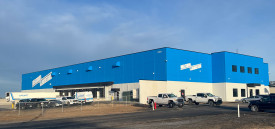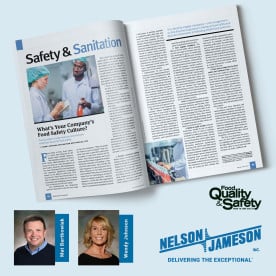sanitation
- March 31, 2021
Springtime brings many new colors, from the flowers popping up in gardens to the spring and summer produce offerings at the grocery store. During this colorful time of year, it might be the perfect opportunity to take a look at color-coding in your facility, whether that means starting a new color-coded program or expanding an existing program.
Nelson-Jameson has expanded our color-coded program once again with the release of our 2021 Color-Coded Catalog. This year's catalog has grown to 68 pages of products that are designed to help prevent allergen migration and cross-contamination. A complete color-coded program helps to lay the foundation for a solid food safety program, and can help minimize the risk of cross-contamination.
Why choose a color-coded system? A complete color-coded system helps promote organization and efficient workflow. Designating critical control areas and zones helps your sanitation program by ensuring that the tools stay in the areas in
- March 08, 2021
It's apparent that we can all safely say that social media has taken over the communication world. "More than 80% of the 4.66 billion people on the planet with access to the internet are social network users... and this share is expected to grow" (Jens, 2020, pp.1). How wonderful, yet crazy, is it to be a click of a button and a typed out message away to talking with a friend in Europe? With social media's ability to stay up to date by the minute, it is the preferred way to communicate for many individuals—especially in the midst of a pandemic. And, not just personally, but professionally as well.
With social media being a time consuming aspect of our daily lives, it can be a valuable tool for both individuals
- February 01, 2021
Resources made available with Nelson-Jameson's Learning Center! This educational learning library was created to encourage our customers to seek out information, when applicable, to aid them in making informed purchasing decisions within the food, dairy, and beverage industries. By providing this free resource for anyone to use, our goal is to have you feel comfortable and confident in the products you purchase.
An intriguing aspect of our Learning Center is that the information we are providing is supplied to us by manufacturers, and industry associations. It is our goal to relay to you the most up-to-date information for your convenience. The information within this resource falls into several categories: Laboratory & QA/QC, Packaging & Ingredients,
- January 04, 2021
Achieve an effective sanitation program in your facility with footwear and surface sanitation products! In the food production process, cross-contamination can occur at any point. Employees can track in a myriad of potential contaminants and unknowingly put an operation at risk each time they breeze through a doorway to a production area. Having an effective sanitation program in place that addresses employee hygiene is key.
A primary route of contamination is the bottom of people's shoes, so cleaning footwear has become just as important as washing hands when coming into a facility. "Items which contact the floor are contaminated and could serve as vectors; despite daily cleaning of high-touch surfaces such as floors, it has already been shown that bacterial and viral contamination return rather quickly" (Pyrek, 2018, pp. 1). To help combat this issue, Nelson-Jameson carries several options for minimizing contamination from footwear including:
- November 09, 2020
According to the FDA, "one of the most commonly documented food safety problems in plants have involved sanitation monitoring, including checking food-contact surfaces and plant cleanliness" (Schug, para. 1). To make matters even more complicated, the
COVID-19 pandemic disrupted normal operations as well for countless food and beverage manufacturers. Disruptions may occur due to limited staff because of layoffs, social distancing requirements, or sickness. These situations on top of the normal expectations of having a clean food plant, can lead to the need of resources for food safety sanitation.It is essential that food manufacturers create safe, quality food, therefore, routine practices need to continue, and additional sanitation protocols may need to be added. Employers also need to ensure a safe environment for their staff, including minimizing the risk of being exposed
- September 24, 2019
Tank cleaning technology has advanced as improvements to hygienic standards have changed. As that change has taken place, priority has been placed on cleanliness of equipment
- December 09, 2015
You may have seen our announcement earlier this year that we started working with Cherney Microbiological Services to provide educational opportunities for customers interested in learning more about food safety, sanitation, and a host of other topics.
Well, we are happy to announce that Cherney has released their Cherney College course offerings for 2016!
Contact us at [email protected] or call 800-826-8302 if you would like to learn more about any of the following course offerings or to register (early bird discounts are available for registrations submitted 30 days prior to the course date). Courses are held in Green Bay, Wisconsin.
Course






